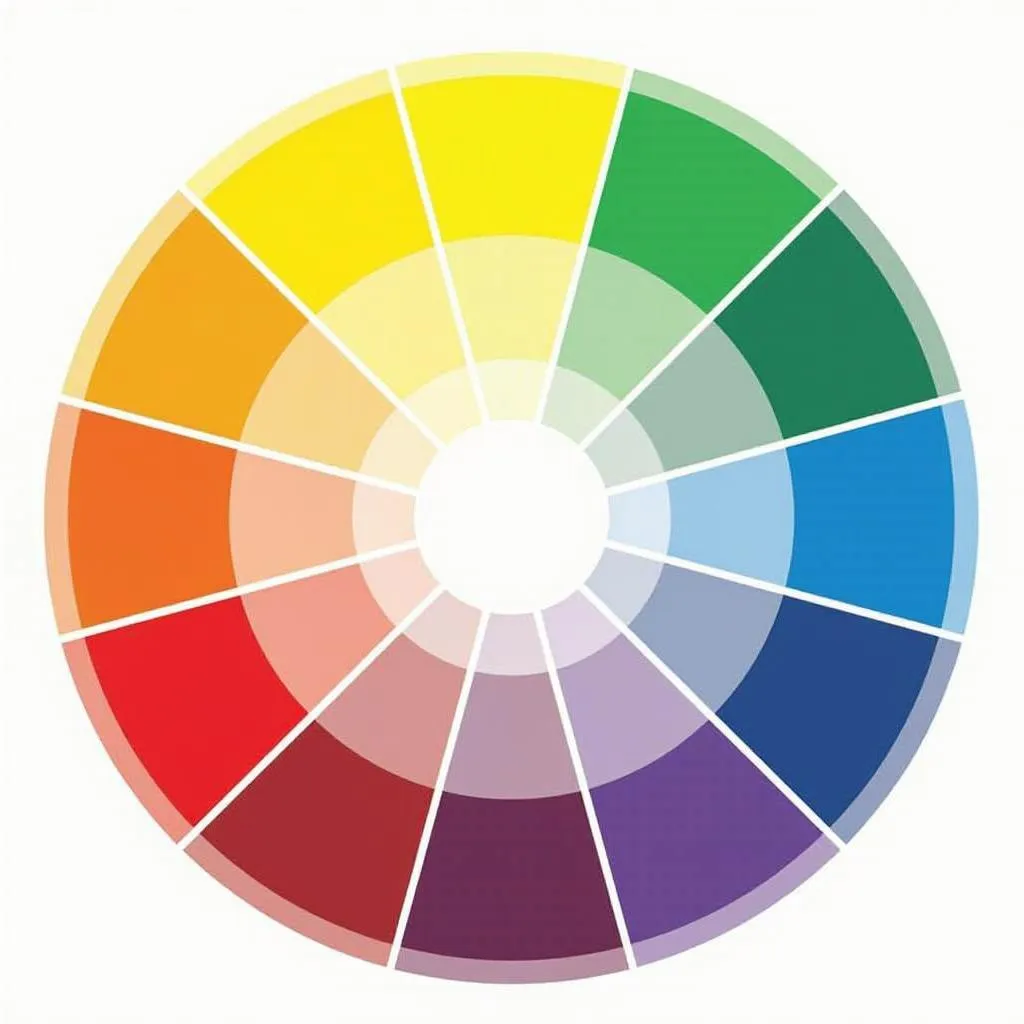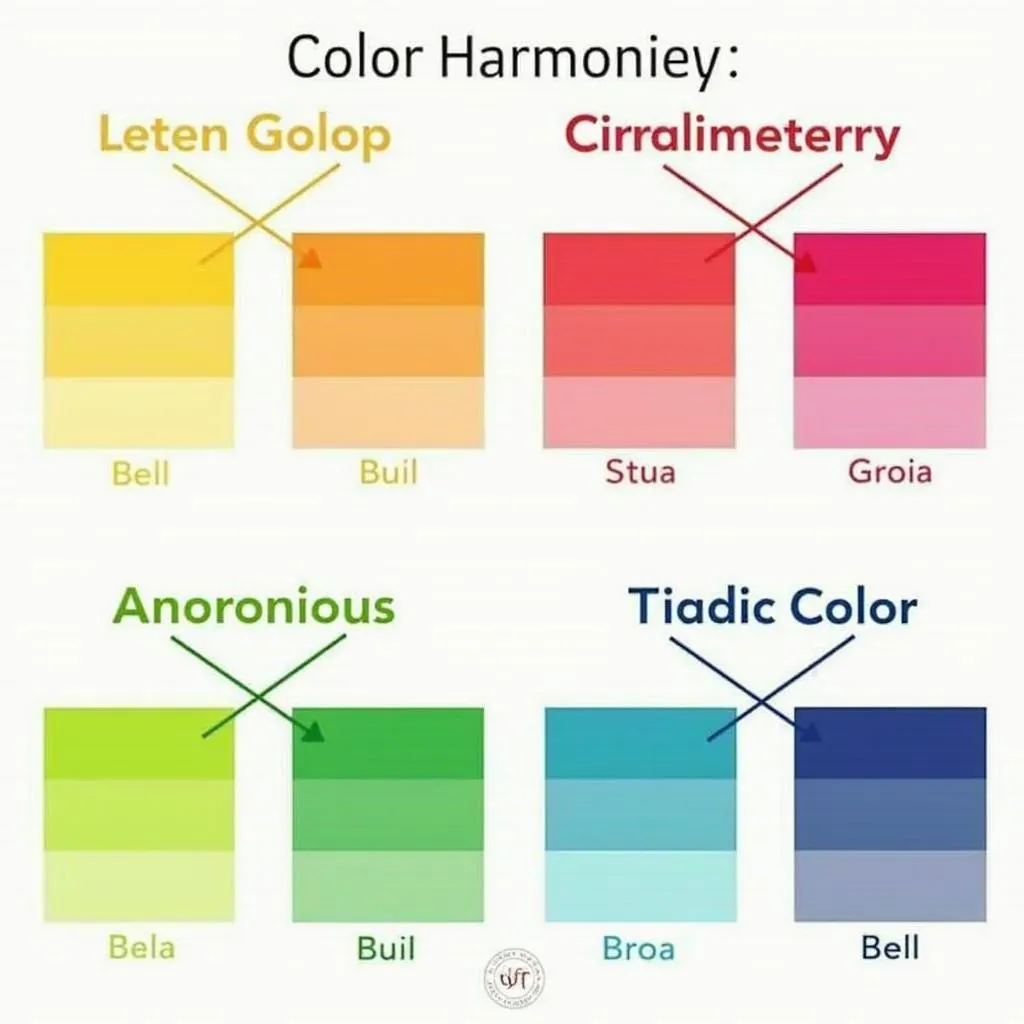Understanding how to use a color wheel can completely transform your approach to color, whether you’re painting a room, choosing an outfit, or creating art. This powerful tool unlocks a world of color combinations, helping you achieve stunning results. Let’s dive into the fascinating world of color wheels and discover how you can use them to mix colors effectively.
Understanding the Color Wheel Basics
The color wheel is a visual representation of color relationships, arranged in a circular format. It’s based on the three primary colors: red, yellow, and blue.
- Primary colors: These are the foundation of the color wheel and cannot be created by mixing other colors.
- Secondary colors: Mixing two primary colors in equal parts creates secondary colors. For example, red and yellow make orange.
- Tertiary colors: These colors result from mixing a primary color with an adjacent secondary color. Such as red and orange creating red-orange.
 Color Wheel with Primary, Secondary, and Tertiary Colors
Color Wheel with Primary, Secondary, and Tertiary Colors
Color Harmonies: Creating Pleasing Combinations
Color harmonies are scientifically proven color combinations that create visually appealing and balanced palettes. Here are a few examples:
- Complementary colors: These colors sit opposite each other on the color wheel, like blue and orange. They create high contrast and vibrancy when combined.
- Analogous colors: These colors sit next to each other on the wheel, like blue, blue-green, and green. They offer a harmonious and calming effect.
- Triadic colors: This scheme uses three colors evenly spaced on the color wheel, like red, yellow, and blue. It provides a vibrant yet balanced look.
 Examples of Color Harmonies on a Color Wheel
Examples of Color Harmonies on a Color Wheel
Understanding these harmonies can help you create stunning color combinations in any area of your life. For instance, if you’re drawn to blue, using a complementary color scheme with orange accents can add a dramatic touch to your space.
Tips for Mixing Colors Using a Color Wheel
Now that you understand the basics, let’s explore some practical tips for mixing colors:
- Start with a limited palette: Begin with two or three colors you love and explore their possibilities before adding more.
- Gradually add color: When mixing, start with the lighter color and gradually add the darker one until you achieve the desired shade.
- Test your colors: Always test your mixed color on a small, inconspicuous area before applying it to your final project. This allows you to make adjustments and avoid any surprises.
Beyond the Basics: Exploring Hue, Saturation, and Value
Beyond the basic color wheel, there are other aspects of color to consider:
- Hue: Refers to the pure color itself, such as red, blue, or green.
- Saturation: Describes the intensity or purity of a color. A highly saturated color appears vibrant, while a less saturated color seems duller.
- Value: Indicates the lightness or darkness of a color.
By understanding these concepts, you can create even more nuanced and sophisticated color palettes.
The Color Wheel: Your Guide to a World of Color
The color wheel is an invaluable tool for anyone who wants to master the art of color mixing. From understanding basic color relationships to exploring advanced color theories, the possibilities are endless. Need to choose colors that complement yellow? A color wheel can help! By utilizing this powerful tool, you can unlock a world of creative possibilities and bring your color visions to life.
FAQ
- Can I use any color wheel for mixing colors?
Yes, most color wheels follow the same basic principles. However, some may have more detailed color variations. - What if I can’t achieve the exact color I want?
Don’t be afraid to experiment! Sometimes, unexpected color combinations lead to beautiful results. - Is there a “wrong” way to use a color wheel?
Not necessarily. The color wheel is a guide, and personal preference plays a significant role in color choices. Trust your instincts!
Ready to Transform Your Space with the Power of Color?
Contact Color Box Hà Nội at 0373298888 or [email protected]. Our expert team can guide you through every step, from selecting the perfect color palette to achieving a flawless finish. Visit our showroom at 86 Cầu Giấy, Hà Nội, and let us help you create a space that reflects your unique style.

